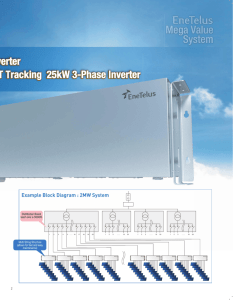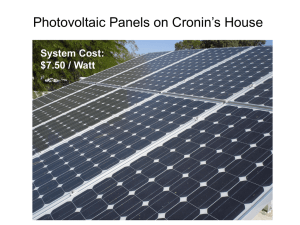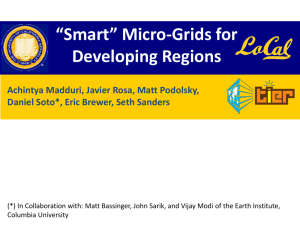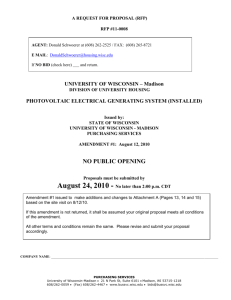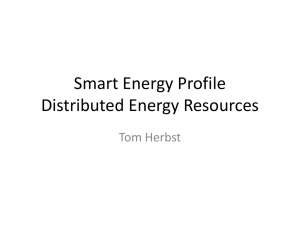講義下載1
advertisement
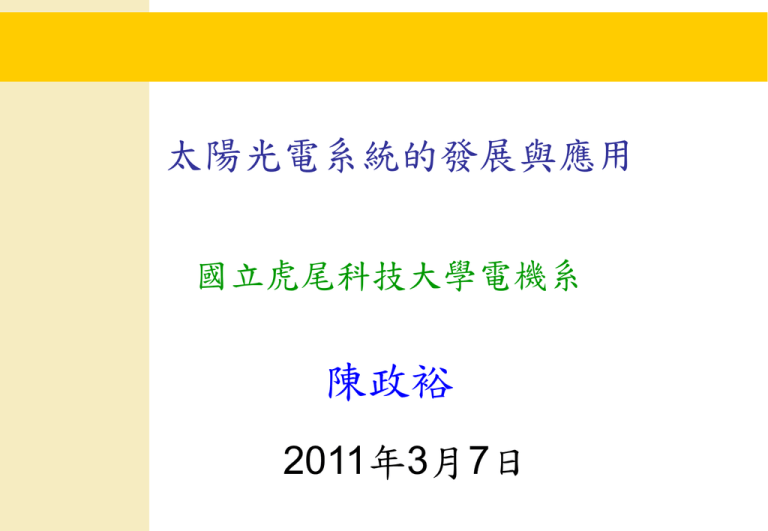
內 容 太陽光電系統的發展與應用 國立虎尾科技大學電機系 陳政裕 2011年3月7日 大綱 內 容 1. 地球的能源與環境問題 2. 太陽光電的發展 3. 台灣的PV政策與設置推動狀況 4. 太陽光電系統簡介 5. 太陽光電系統的應用 內 容 下個50年要面對的前十大問題 內 容 能源的挑戰: 人類還能揮霍多久 內 容 (2005–2030E) Global Energy Consumption 內 容 地球各類再生能源的潛力 太陽能 蘊藏量最大無限制 內 容 2000到2100年全球主要能源需求預測 全球暖化的影響 內 容 永續的能源 現在常用的能源: • 石油 • 煤 • 天然氣 • 核能等 可能問題: • 地球儲量有限 • 產生CO2等氣體 • 溫度上升 能永續使用的再生能源: •水力發電 •風力發電 •太陽光發電 •太陽能熱水器 太陽能直接應用 •太陽熱能發電 •生質能 (利用天然材料) 熱轉換 (經燃燒產生熱或以氣化及裂解產生燃氣/燃油) 化學轉換 (經發酵或脂化產生酒精/汽油/柴油/沼氣) 生物轉換 (利用生物菌種等產生沼氣/甲醇/氫氣) •海洋能發電 •地熱發電 •燃料電池 (把燃料利用觸媒轉換成電能) 傳統火力發電:每度電約產生0.53公斤的CO2 太陽是能源之母 • 太陽是地球上所有能源的源頭,目前已知的能源幾乎都直接或間 接來自太陽。 (如石油、煤、天然氣、水力、太陽能、風力、光合作用、海洋 能等等 ,只有核能與地熱除外。 ) • 太陽光照射整個地球表面 1小時內的能量(~5×1020 J),約可供全 人類使用 1 年 (2005)。 • 太陽還可以繼續發光至少 50 億年以上。 • 太陽能是免費、取之不盡、用之不竭之潔淨能源,但必須找到有 效的使用法。(太陽能包含太陽光電與太陽熱能) 真實世界面臨的問題 內 容 88水災, 莫拉克颱風 內 容 15億人還缺乏電力 內 容 Global Electricity Generation and Consumption by 內 容(2010–2030) OECD and Non-OECD Countries Sources of Global Electricity (2010–2030) 內 Generation 容 容 Greenhouse Gases 內 (grams/kWh of CO2) 太陽能利用率還很低 內 容 Annual PV Power Generation 內 (TWh) 容 by End-Use Sector Content 內 容 1. 地球的能源與環境問題 2. 太陽光電的發展 3. 台灣的PV政策與設置推動狀況 4. 太陽光電系統簡介 5. 太陽光電系統的應用 太陽電池的發展史 •1954年Bell Labs發展出矽太陽電池 (Chapin等人,轉換效率約4.5%) •1956年第一個太陽電池製作成功 •1958年開始太空應用(GaAs) 衛星應用 •1970年開始太陽光發電系統地面應用(Si) (能源危機) •1976年Carlson製作出第一個非晶薄膜太陽電池 •1980年消費性薄膜太陽電池應用(a-Si, CdS/CdTe) •1990年與公用電力併聯之太陽光發電系統技術成熟(Grid-Connected PV System, Si) (歸功電力電子技術之進步) •1992年起歐、美、日各國推動PV補助獎勵 •2000年建材一體型太陽電池應用(BIPV) 日本太田市住宅區應用(553戶) 太陽光電的發展歷程 內 容 太陽電池材料種類 單晶矽 Single Crystalline 矽(硅) 晶矽 多晶矽 Crystalline Poly Crystalline η:12~20% η:10~18% Silicon 多晶矽薄膜 Thin Film Poly. 非晶矽薄膜 Solar Cells Amorphous Thin Film (Si:H, SiGe, SiC..) 多元化合物 η: 6~8%,應用消費 性產品、玩具等 單晶 Single Crystalline (GaAs, InP..) Compound Nano & Organic 明日之星 ? 多晶 Poly Crystalline (CdS, CdTe, CuInSe2...) η: 18-30 % (應用於太空或聚光型 PV 系統) Thin Film (部份已淘汰或生產技 術尚未成熟) 如 TiO2/染料、有機太陽電池,目前研發中 太陽電池材料分類 內 容 不同太陽電池材料對應太陽光譜波長圖 美國聚焦PV性能/價格技術改善 資料來源: DOE Solar Energy Program Overview, DOE Solar Energy Technologies Program, Aug. 2007. 內 容 國際太陽電池實驗室效率 太陽光電產業鏈 內 容 Content 內 容 1. 地球的能源與環境問題 2. 太陽光電的發展 3. 台灣的PV政策與設置推動狀況 4. 太陽光電系統簡介 5. 太陽光電系統的應用 台灣太陽光電發展歷史 1980-1990 -Mono-crystalline silicon(2 inches), amorphous silicon(ITRI) -Sinonar Amorphous spin-off from ITRI(1987) 1991-2000 -mono-crystalline silicon(4 inches,1992,ITRI) -Motech founded(2000) 2001-Initiate PV promotion program(2001,MOEA) -Blooming solar PV research(2005) -dye-sensitized(2002),thin-film and others(2005) -DelSolar spin-off from ITRI(2004) -3 ingot/wafer, 8 C-Si solar cell(2006/9) -Renewable Energy Act waiting for legislation approval 台灣再生能源目標 2006 2010 2015 2025 MW % MW % MW % MW % 1.Hydro 1,911 5.1 2,168 5.7 2,261 5.1 2,500 4.4 2.Wind Power 203.7 0.5 980 2.6 1,480 3.4 3,000 5.3 3.Solar Power(太陽光電) 1.6 0.0 31 0.1 320 0.7 1,000 1.8 4.Geothermal --- 10 0.0 150 0.3 5.Biomass 600 850 1.9 1,400 2.5 6.Fuel Cell --- --- 50 0.1 200 0.4 7.Ocean Energy --- --- 1 0.0 200 0.4 Total 2,716 3,910 4,972 Share of RE power in national electricity generation capacity --1.6 7.3% 741 10.3% 1.9 11.2% Note: national electricity generation capacity (excluding self-use power): 2006 37.38GW; 2010 38.28GW; 2015 44.18GW; 2025 56.64 GW 8,450 14.9% 內 容 台灣地區電力系統容量分佈圖 內 台灣太陽光電產業現況 容 內 容 2010年台灣地區併網型太陽能發電系統概觀 內 容 國際上光伏是優先發展分佈式發電 Content 內 容 1. 地球的能源與環境問題 2. 太陽光電的發展 3. 台灣的PV政策與設置推動狀況 4. 太陽光電系統簡介 5. 太陽光電系統的應用 太陽光電發電是什麼? • “太陽光電發電” “太陽能熱水器” “太陽能熱發電” • 太陽光電的英文為 “Photovoltaic”(簡稱 PV)。 • 太陽電池構造與太陽光電發電原理: •太陽電池是以 N 型與 P 型半導體 •當陽光照射太陽電池 時,光子的能量會使半 導體材料內的電子脫離 軌道 ,產生電子與電 洞,並分別往負(N型) 與正(P型)極方向移動 材料接合構成正 極與負極。 •正、負極接上負載時,將 有電流流出,可以使燈泡 發亮、馬達轉動。 負 載 + 電流 太陽光電發電之特點 1.太陽電池(Solar Cell )可將光能直接轉換為直流電能 ,但不會儲存能量。 2.使用時無需燃料、無廢棄物與污染、無轉動組件與噪音。 3.太陽電池模板壽命長,可達二十年以上 。 4.系統容量可依需求設計,應用廣泛(小至消費性產品-- 如計算 機,大至發電廠 )。 5.系統發電功率大小隨日照強度(單位W/m2)而變,可以輔助 市電尖峰電力之不足(併聯型系統)。 6. 模組除發電功能外,亦可設計成具有一般建材之隔熱、隔音 、遮陽等功能,即可與建築物結合(BIPV)。 美國NREL未來屋太陽能與氫能願景 陽光社區案例- 荷蘭 1MWp decentralized and building integrated PV system in Nieuwland, a new housing area of Amersfoort . Location: Amersfoort, the Netherlands Sunshine hours (annual average): 4.05 hours per day Type of project: Mostly residential buildings, some public facilities Type of application: BIPV Design process: Different for different housing sections Time for construction: Different for different housing sections, from 1997 to 1999 Realization: 1999 A 1 MW PV system in an urbanized area through the realization of 500 PV houses grouped together. 39 PV發電系統之一般架構 PV system Master control and monitoring (MCM) Power conditioner PV converter DC conditioner Inverter (PV Array) Interface d.c./d.c. Interface a.c./a.c. AC utility interface Storage Auxiliary d.c. supply DC load Auxiliary AC a.c. supply load Utility PV generator之 I-V特性 generator:PV array, PV string, PV module Voc:開路電壓(V) Isc:短路電流(A) Pmp:最大輸出功率(W) Vmp:最大輸出功率時之電壓(V) I 電流源 Isc Pmp Imp 電 壓 源 輸出功率 Imp:最大輸出功率時之電流(A) Fill Factor (FF) = (Vmp × Imp / Voc × Isc) × 100% Vmp Voc 太陽電池效率 (Efficiency) = (Pmp / 輸入日照功率) × 100% *輸入日照功率(W) = 太陽電池面積(m2) ×日照強度(W/m2) *太陽光電模組之額定值乃在STC (1,000 W/ m2、AM1.5、25℃)下測試。 *太陽電池在開路、短路時皆不會燒毀 V 太陽電池之串並聯電氣特性 • 串聯 電流(A) 電壓(V) 電流(A) • 並聯 電壓(V) 圖片來源: “Planning and Installing Photovoltaic Systems” PV模組電氣特性-一般(I) 模組功率 模組電流(A) 模組電壓(V) VOC:開路電壓(V) ISC:短路電流(A) VMPP:最大輸出功率時之電壓(V) PMPP:最大輸出功率(W) IMPP:最大輸出功率時之電流(A) 圖片來源: “Planning and Installing Photovoltaic Systems” PV模組電氣特性-溫度影響 (III) current-temperature coefficient (α) 75oC 50oC 25oC 0oC 7 6 1,000W/m2 5 (A) 電流 4 3 Battery voltage 500W/m2 2 1 0 0 5 10 15 電壓 (V) 20 25 voltage temperature coefficient (β) •太陽電池溫度升高時,模組輸出電壓與最大輸出功率將降低 •Vmp = 17Vdc 之太陽電池一般設計對應 12Vdc 之蓄電池 •最大功率點追蹤(MPPT)為維持發電性能之重要機制 驗證標準 模組驗證規範(性能/環境測試) -矽晶標準: IEC-61215、JIS-C8990、CEC-503等 -非矽晶標準: IEC-61646、JIS-C8991、CEC-701等 -驗證機構:德國 TUV、美國UL、日本JET等 直交流轉換器(Inverter)驗證規範(併聯相關) -標準:VDE 0126、 VDE 0126-1-1、UL 1741、IEEE 929、 IEC 62109 、JET等 -驗證機構:德國 TUV、BGFE 、美國UL、日本JET 、英國ETL等 註:Inverter譯成直交流轉換器、變流器等 內 獨立型太陽能發電系統 容 內 併網型太陽能發電系統 容 Distributed Generation Technologies Electric Power System (primary) Adjacent Customer or loads (if any) HV Protective Device Step-up transformer Metering Power System Interface Controls Grid Tied Power Inverter PCC and Primary Voltage Level Interface Equipment LV Protective Device LV Switching Device Power Converter Static Power Converter Fuel cell Photovoltaic Cells Renewable Energy Synchronous Generator Wind turbine Induction Generator Combustion turbine or microturbine Internal Combustion Engine Prime Energy Source Components of solar system Solar (PV) cell: Silicon base solar cells convert sunlight directly into electricity. PV panel or PV module: Solar cells assembly. Efficiency about 12-18% PV inverter: Converting solar energy to useful AC power. Grid tied: Feed-in solar energy into utility grid. Stand-alone(off grid): output for local load as UPS’s inverter. Grid Tie Residential System Content 內 容 1. 地球的能源與環境問題 2. 太陽光電的發展 3. 台灣的PV政策與設置推動狀況 4. 太陽光電系統簡介 5. 太陽光電系統的應用 大型太陽能發電站 內 容 偏遠地區/高山的應用例 獨立型太陽光電發電系統應用例 "Freiburger Hutte" in the Austrian Alps, close Lech 太陽電池手機充電器產品實例 太陽能充電器的例子 Mobile phone with PV power supply 日本NTT DoCoMo公司 在2004年2月中發表的口 袋能源Pocket Energy,用 太陽能為你的手機、 PDA、Game boy、MP3 播放器及其他移動設備充 電。 太陽能車應用例 交大太陽能車 •資料來源: National Chiao-Tung University, Taiwan 軍事應用 Wearable Power 資料來源:Konarka Technologies, Inc. PowerCloth™ Technology Brief of內 grid容 tied inverter 1. Digital based control 2. Maximum Power Point Tracking (MPPT) control to capture the maximum power from PV panel 3. Anti-Islanding Protection 4. High efficiency topology & components selection 5. Isolated & Non-isolated base on country rule 6. Reliability – Natural Cooling Auto Diagnosis Part count reduction Product Range 1. _Transformer string inverter 1-6KW 2. _Transformerless string inverter 1-10KW 3. _ Mini central 3 phase inverter 10-30KW 4. _ Central inverter up to 1MW 內 容(TL) Transformerless Inverter 內 容 High Frequency Transformer (TR) 內 容 (TR) Low Frequency Transformer 內 容擁有較高效率 Transformerless Inverter Source: US CEC Inverter list 內 容 MPPT Control Algorithm 內 容 Generation) 分佈式發電系統(Distributed 內 容 智能電網和微電網(Smart Grid and Micro-Grid)
